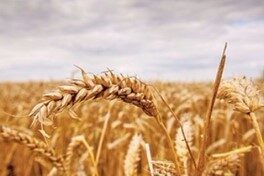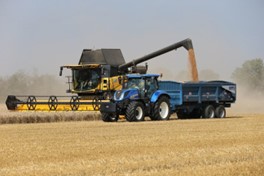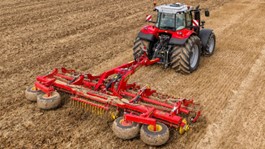Harvest 2023 is just around the corner with Winter Barley and Oilseed rape quickly ripening. Before harvest kicks off in full swing it is always worth reminding growers of good management tips for the up coming harvest.
Desiccation
As it stands Glyphosate is still permitted pre-harvest on cereal crops to help improve harvesting speed, maintain quality and control any weeds that have germinated late in the crop. Many crops have turned quickly in the high heat, but in some instances there may still be green straw. This may slow down combining and lead to greater losses at harvest. Where this is the case, pre harvest roundup may want to be considered, however with the cost increase of roundup this is no longer a cheap pass.
Before any crops are desiccated it is important to check your contracts with merchants to ensure the use of Glyphosate is permitted. Some Milling and Malting Barley contracts will prohibit the use of Glyphosate for pre harvest desiccation. Do not use Glyphosate on any seed contracts or for farm saved seed.
The correct timing is when the grain is below 30% moisture; at this stage, the grain should just take a thumbnail print. It is important to observe the harvest interval of 7 days for cereals, however in many cases this may be more realistically 10-14 days before crops are ready to combine. If you are planning to treat large areas with a pre-harvest desiccant, combining capacity should be taken into account as straw quality and standing ability will deteriorate following desiccation. We would only advise on desiccation of cereal crops if absolutely necessary as it is important we help to minimise any residues.


Peas and Beans
For Pea and Bean seed crops, we have no longer got access to Diquat. Therefore these will have to be direct cut. For the last couple of years Spotlight Plus (Carfentrazone) has recieved a late one year emergency authorisation, this has not been approved for this year yet. They may get EAMU’s approved over the next couple of years however this is not guaranteed.
Glyphosate can be used on non-seed crops, when the grain moisture is below 30%. This is particularly necessary on crops where Bindweed or other Broadleaved Weeds are present.
Harvest Management
This years weather has proven challenging, with many locations receiving over 900mm of rain from November-May. A dry windy June has seen ground dry up rapidly, with widespread surface cracking and ultimately we are now entering harvest with dry conditions. This should hopefully reduce the level of compaction at harvest, however good harvest management is still key to protecting soils.
Simple steps can help minimise compaction:
- Keep trailers on tramlines or headlands where possible, particularly where soils are still wet.
- Stack straw on the headlands, and if at all possible confine straw lorries and anything on super single axles to the headlands, or even better on farm tracks. Bale chasers on flotation wheels may prove valuable here.
- Chop straw on notoriously wet areas of fields to avoid balers, loaders and straw trailer damage.
Unsurprisingly there are a lot of ruts and wheeling’s evident this year, especially on tramlines. Before cultivations begin, it is essential to examine soil structure prior to deep cultivations and sub soiling this year, making sure compaction layers are being removed. Where sub soiling needs to be undertaken we would advice to do this whilst conditions are good to help get the “shattering” required to break any pans.
We would only encourage farms to do this where absolutely necessary, and if soil hasn’t been compacted then deep cultivations can be avoided. Sub soiling whilst the ground is dry will lead to greater cracking and alleviate more compaction but soil moisture and seed bed quality may be compromised. Low disturbance subsoilers can offer a benefit here.
Where contractor balers and combines are being used, we would strongly encourage you to ensure they blow machines down prior to entering the farm. This has been the cause of many fields being infected with black grass and rye grass. If you are moving machinery from a “dirty” field to a “clean” field, taking the time to blow machinery down may also prove valuable! This is also the case with demonstration machinery coming onto farms.
Cultivations:
Stale seed beds often prove valuable for the control of grass weeds. Stale seed beds will only prove effective where moisture is present, so timing of cultivation is critical. With plenty of soil moisture currently present, stale seed beds could be very effective this summer. Where dry conditions occur, a greater loss of grass weed seeds may be lost through predation and natural losses over time. If conditions are too dry at the time of cultivation, weed seed dormancy may be induced. Therefore leaving the seed on the surface may prove to be more effective. Creating a seed-bed suitable for a grass ley must be the aim to maximise grass weed germination, therefore we encourage you to produce a fine firm stale seed bed, cultivating to a depth no greater then 5cm and rolling after wards.
Over the last couple of years where more farms are practicing non inversion tillage, Brome species are becoming more prevalent. Where bromes are the main problem weed species and farmers do not wish to plough, shallow cultivations (5 cm) will prove effective for sterile and great brome. However, for soft brome and meadow brome which are becoming more common on farm it is important to leave stubbles uncultivated for a month, as early cultivation will induce seed dormancy.

Where levels of grass weeds are at a very high level, we would strongly encourage you to plough to bury as many seeds as possible. This will only be effective if ploughing has not occurred for a number of years and full furrow inversion is achieved.
When stale seed beds are going to be destroyed it is important to ensure the safe use of Glyphosate to avoid resistance. Always use the correct dose of Glyphosate, and avoid applications in poor environmental conditions. Depending on the brand, Glyphosate will require 1-6 hours rainfast, and shouldn’t be applied in temperatures over 25 degrees. Small grass weeds will only require 540g/l Glyphosate, but larger grass weeds will need between 720-1080g/l. Please consult your agronomist before application. It is important to monitor control to ensure no resistance is present.
Previously where oilseed rape stubbles are to be cultivated, it is advisable to leave ground undisturbed for a minimum of 3-4 weeks. Studies have found that moving the soil prior to this can induce seed dormancy and therefore cause problems with oilseed rape volunteers in the future. This may be a particular issue where erucic acid is becoming a problem as volunteers are believed to be the main cause of this.
However recent work from Niab Tag has found that cultivating oilseed rape stubbles between mid July-Mid August, when cabbage stem flea beetle pupae are still on the top surface of the soil can lead to significant reduction in cabbage stem flea beetle emerging from those fields.
We would therefore encourage farmers to cultivate the top 2-5cm of oilseed rape stubbles shortly after harvest to aim to reduce emergence of cabbage stem flea beetle. It is important that this is done prior to the emergence of cabbage stem flea beetle whilst they are still in the pupae form and can be easily killed. It may also pay to roll after cultivations. Oilseed rape volunteers can then predominantly be controlled using a wide rotation on residual herbicides.
Should I remove my straw?
Last year saw a significant increase in phosphate and potash however these have now come back to more palatable levels. Whilst each farm system is different, ultimately improving soil health and organic matter is key, especially if entering into the SFI. Chopping straw has many benefits including giving soil cover, returning nutrients to the soil and giving a food source for soil microbes. Therefore we would only encourage straw removal where it is rotationally replaced with organic manures. Where straw is being sold off farm it is worth making sure that the value of straw is being truly recognised. If straw is being removed then select fields with high potash indices, where slug pressure is likely to be high or where straw for muck deals can be made. If farms have low organic matter or low potash indices we would advise against removing straw.


Catch and Cover Crops
Many farms may wish to still plant cover crops and catch crops for a range of reasons such as nutrient retention, protection from soil erosion and to try to increase soil organic matter. Establishment, destruction and cover crop choice are all essential when choosing cover crop options. If growing under the CSS options or for water companies, there are species requirements and dates that need to be met. Please check before planting. For further information please follow the link below or contact your agronomist.
A Guide to Growing Cover Crops



